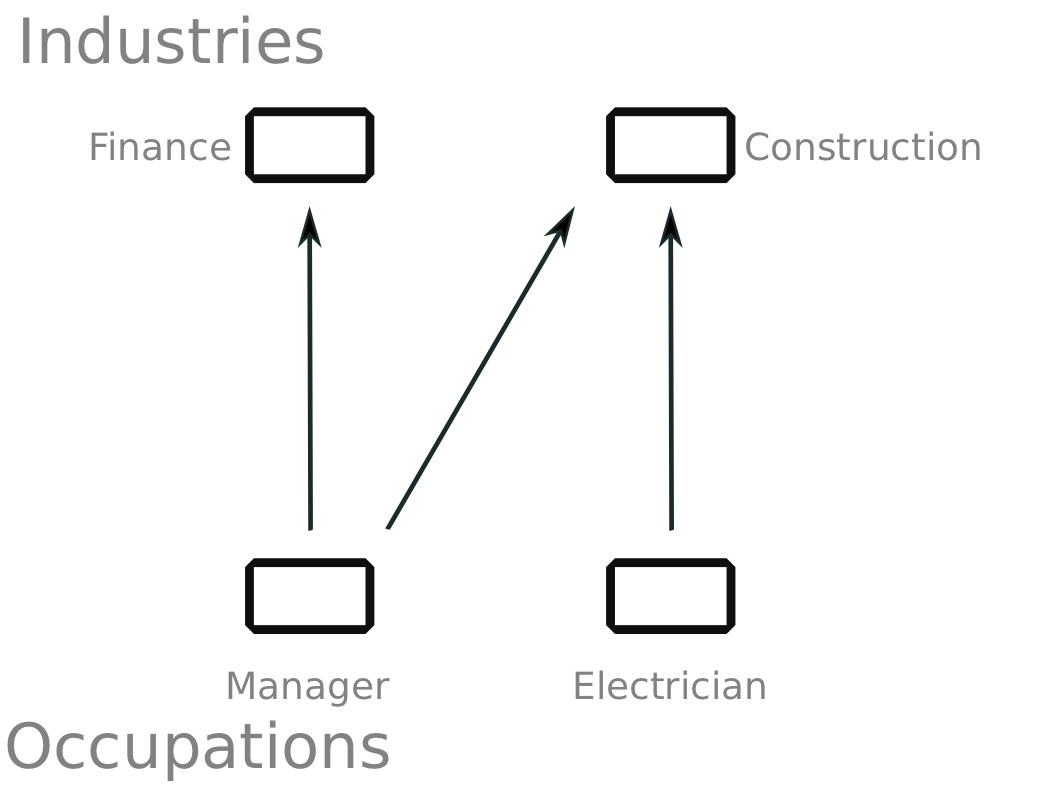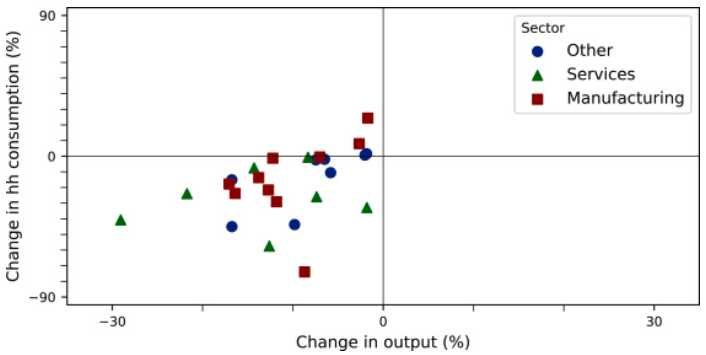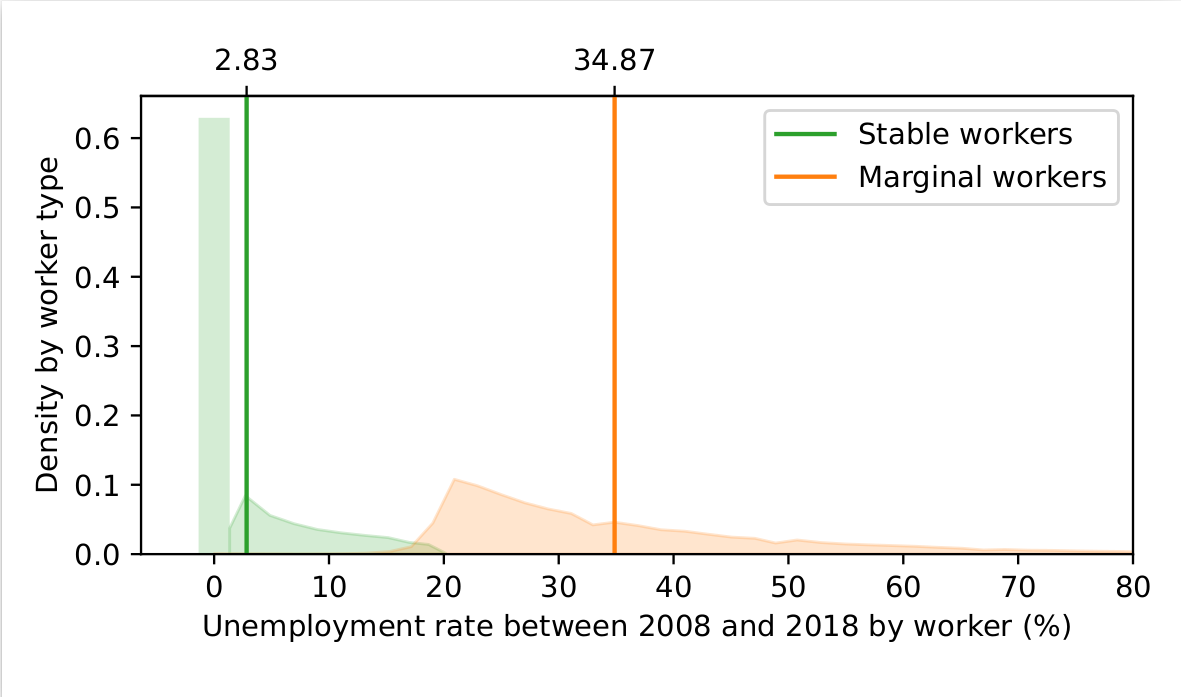
I am a research economist at the Danish central bank - Danmarks Nationalbank. I study labor markets and the macroeconomy using both administrative records and quantitative models. Contact: sdma at nationalbanken.dk
Upcoming presentations
- October 2025: Lund University, Nordic Central Banks' Researchers' Workshop
- November 2025: Banco de Portugal
- December 2025: ES Winter Meetings*
Publications
Danish Flexicurity and Occupational Mobility: A Comparison with the United States (Economic Letters, forthcoming)
We compare Danish occupational mobility rates -- occupation by occupation -- to that in the United States, taking care of miscoding in the latter. We find significantly lower gross and net mobility in Denmark.
Occupation-industry mismatch in the cross-section and the aggregate (JPE Macro, 2024)

Recessions that generate more mismatch do not inherently generate more unemployment. I show this modelling "broad" occupations -- that are employable in many industries, and thus less at the risk of mismatch. The model also suggests the average broadness of the unemployed as a useful measure of mismatch.
Dispersed consumption versus compressed output: assessing the sectoral effects of a pandemic (Journal of Macroeconomics)

Credit-card transaction data are popular when sharp economic changes need to be monitored in real time. Yet, because of input-output linkages, sectoral output responses are very different from what the sectoral consumption data implies.
Working papers
Why are marginal workers unemployed: low productivity or high outside options? (conditionally accepted, Labour Economics)

15% of Danes ("marginal workers") make up two thirds of unemployment. Are they less productive, or do they have better outside options (=enjoy unemployment more)? I answer this using both administrative records and a model calibration.
On-the-Job Search and Inflation under the Microscope
CEPR Working Paper • Danmarks Nationalbank WP • Bank of Finland, Bundesbank Spring conference 2024, SED 2024, ECSB Cluster 2 (2024), ECSB Cluster 1 (2024)Job-to-job transitions are (wage) inflationary and decrease vacancy posting, thereby challenging the traditional view on the relationship between inflation and unemployment. The model explains the effects of the 2012 Danish reform on employment transitions and wage growth.
Getting Real About Wages: A Nonhomothetic Wage Deflator
draft • ES Winter Meetings 2025Conventional real wages—nominal wages divided by a consumption deflator—are biased from a welfare perspective when households value leisure and exhibit nonhomothetic consumption behavior. We derive a true wage deflator and show that standard measures underestimate real wage growth and welfare growth between 1984 and 2019. Our deflator leads to similar conclusions as the conventional CPI deflator when studying the evolution of wages during the post-Covid inflation surge.
Confused about Careers? Untangling Occupational Mobility, Miscoding and Distance
CEPR discussion paper • Danmarks Nationalbank WP • EALE 2023, World Labor Congress 2025US surveys on occupations contain a lot of mistakes. We estimate these mistakes and show that they not only lead to false estimate of whether an occupational change occurred, but also how far it was. Miscoding can also be informative about occupational distance itself, since closely-related occupations are more likely to be miscoded into each other.
Why VAT Pass-Through Varies Across Countries: The Role of Market Power

The pass-through of value-added taxes depends on market concentration. European countries differ significantly in their average market concentration, which explains 16% of the cross-country differences in VAT pass-through.
Workplace Amenities and the Gender Wage Gap: Evidence from Denmark
draft •We use a rich set of individual-level amenities to show that gender-differences in amenity selection (even within narrowly defined occupations) affect the gender-wage gap.
Wedged Between Theory and Practice: Log-Linearization and Deflation Biases in Business Cycle Accounting
draft •
Work in progress
Amenities within industries and occupations
note •We discuss how to extract amenities using a standardized work-environment survey and demonstrate cross-sectoral difference in amenity exposure.
Non-homothetic preferences and relative price shocks
draft • PEJ 2023In the aftermath of the pandemic, many countries subsidized prices of essential goods via lower VAT, arguing that subsidizing essential goods is an effective way to support low-income households. Is it? We answer this question taking seriously both non-homothetic preferences and an imperfect pass through of VAT.
Better the Devil You Know: Women's Job Mobility and the Hidden Risks of Workplace Change
We document: women care more about workplace-related amenities than men; these are less prevalent in male-dominated occupations; women's job mobility is lower in these occupations, and their job changes coincide with higher wage growth. We rationalize these findings with a job-ladder model in which social amenities are unobservable prior to accepting a job.
Worker protection and screening
draft •Workers differ ex-ante in their ability to find a good match. Firm can either learn match quality during hiring, or on the job. A worker protection policy that makes layoffs more difficult makes hiring more risky. The model features a screening externality: the more firms screen, the worse the applicant pool, the more important screening.
Policy work
The pressure on the labour market has eased after a job-intensive expansion (Danmarks Nationalbank Analysis 6-2024)
Employment has increased significantly in Denmark, the euro area and the US during the post-pandemic expansion, with stronger growth relative to GDP than in previous expansions. Employment growth is due to several reasons. One of them is a fall in real wages: when labor is cheap, more of it is employed -- especially less-skilled workers.
The role of marginal workers in Danish unemployment (Danmarks Nationalbank Memo 7-2023)
Unemployment risk is highly heterogeneous in Denmark: a group of marginal workers constitutes 15 per cent of the labour force but makes up roughly 60% of the unemployed in Denmark. These marginal workers cycle more through jobs, have longer and more frequent spells of unemployment and leave their jobs at higher pace. Empirical evidence suggests that they are less productive, and more dependent on labor income.
The impact of digitalisation on Danish companies and workers (Danmarks Nationalbank Memo 1-2022)
Using micro-level data from the period 2001-2018, we document the increased digitalisation of the Danish economy and analyse the effect of digitalisation on sectoral and firm performance measured by sales. Within sectors, large firms that increased their usage of digital goods on average grew faster in terms of sales. We examine the evolution of the workforce in the IT sector and we find that workers have become more specialised over the last decade. The data are consistent with the hypothesis that this higher specialisation is associated with higher productivity; however, it might reduce the resilience of the IT labour market against economic shocks.
Three lessons from the Danish wage compensation scheme (Danmarks Nationalbank Memo 5-2021)
The three lessons: First, less educated workers have in general been more affected by the crisis. This is mainly driven by the type of firms that are affected by the crisis, and not the decisions of individual firms. Second, a firm's choice to keep, lay off or furlough workers is also driven by the worker's attachment to the workplace. Firms lay off workers with fewer hours and employees with short employment spells, while workers with high seniority are furloughed. Third, workers earning more than peers face a greater risk of being laid off, while firms furlough workers that are less expensive.